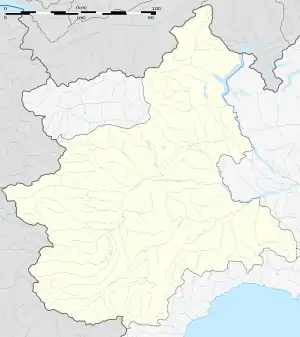Bistagno
Bistagno is a comune (municipality) in the Province of Alessandria in the Italian region Piedmont, located about 70 kilometres (43 mi) southeast of Turin and about 35 kilometres (22 mi) southwest of Alessandria.
Bistagno | |
|---|---|
| Comune di Bistagno | |
 Rail station of Bistagno. | |
 Coat of arms | |
Location of Bistagno 
| |
 Bistagno Location of Bistagno in Italy  Bistagno Bistagno (Piedmont) | |
| Coordinates: 44°40′N 8°22′E | |
| Country | Italy |
| Region | Piedmont |
| Province | Alessandria (AL) |
| Government | |
| • Mayor | Celeste Malerba |
| Area | |
| • Total | 17.59 km2 (6.79 sq mi) |
| Elevation | 175 m (574 ft) |
| Population | |
| • Total | 1,850 |
| • Density | 110/km2 (270/sq mi) |
| Demonym(s) | Bistagnesi |
| Time zone | UTC+1 (CET) |
| • Summer (DST) | UTC+2 (CEST) |
| Postal code | 15012 |
| Dialing code | 0144 |
| Patron saint | St. John the Baptist |
| Saint day | 24 June |
| Website | Official website |
Bistagno borders the following municipalities: Castelletto d'Erro, Melazzo, Monastero Bormida, Montabone, Ponti, Rocchetta Palafea, Sessame, and Terzo.
In the center of the village is the Giulio Monteverde Gipsothèque, which houses the sculptor's original plaster models.
Although the most common and widespread etymology for the toponym is connected with the confluence of two 'branches' of the Bormida river (the Spigno Bormida and the Millesimo Bormida) in the territory of Bistagno (Bistagno < bi + stagno, bi(s)- + pond, where 'pond' would not only indicate a stagnant body of water, but would be also connected with the root *agn- > Latin amnis, in the meaning of 'river', 'water course', 'stream', 'torrent'), a new etymology, based on linguistic evidence, connects Bistagno with *bĭst-ăgnŏ-s (Proto-Indo-European ~ Celtic), which would mean 'small pheasant', and would allude to the presence of this specific bird in the territory of the village in the Neolithic or, in any case, in prehistoric times.[4]
People
- Giuseppe Saracco (1821–1907), politician
- Giulio Monteverde (1837–1917), sculptor
Twin towns
 Flaviac, France
Flaviac, France
References
- "Superficie di Comuni Province e Regioni italiane al 9 ottobre 2011". Istat. Retrieved 16 March 2019.
- All demographics and other statistics: Italian statistical institute Istat.
- "Popolazione Residente al 1° Gennaio 2018". Istat. Retrieved 16 March 2019.
- Francesco Perono Cacciafoco, The Origins of Naming Process: Toponymic Archaeology of Two Indo-European Place Names, in Review of Historical Geography and Toponomastics, vol. 11, nº 21-22, 2016, pp. 64-65.